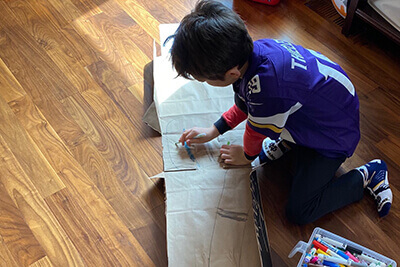April 16, 2020
 by Dr. Bill Hudson, Head of School
by Dr. Bill Hudson, Head of School
If you’ve coached or watched seven-year-olds play soccer, you know that there are essentially two fundamental skills: keep your eye on the ball and keep your head up. Those were basically the same two directives I had in mind when I coached middle school soccer and high school basketball. At first, the two seem to be at odds with one another. Since the ball is on the ground, how can you keep your head up? Yet in order to be successful, you have to be able to do both: to see the ball right in front of you and see the field in order to anticipate where the ball might go next.
Education around the world has changed dramatically in the past month and many young people are hurting because of that—academically, socially, and emotionally. Sadly, a recent national survey found that 95% of 13- to 17-year-olds have had their classes canceled and 41% have had no school at all. I have friends at other schools who are very good teachers and exceptional human beings that are frustrated with their inability to teach. Many students find themselves completing packets that review concepts that have already been taught at the expense of new learning. The inadequacies and injustices in the education system of the United States have become more pronounced in the age of COVID-19. Equity and access present challenges that are proving hard to overcome.
Our reality has been different. MPA teachers have done a phenomenal job keeping their eyes on the ball and keeping their heads up. As I have popped into classes, meetings, and gatherings, teachers are keeping an eye on each student, and looking ahead as they do, leading their students with confidence in the midst of uncertainty. They are successfully transitioning to virtual school while remaining true to our mission of teaching the whole child and prioritizing relationships with their students.
In my Panther Post message several weeks ago, I wrote that disruption and discomfort are the enemies of complacency and can spur personal and professional growth. The sudden shift to learn-from-home has resulted in a good kind of disruption, opening up a golden opportunity for teachers to design lessons for students to engage in authentic, deep learning that is even more self-directed and more playful. I have been inspired by their creativity and innovation. Here are just a few examples of disruption happening at MPA:
- Hannah Lawson gives her orchestra students weekly challenges to tackle for fun outside of class. She posts the challenge songs, gives the students the music, and they have to learn the rest independently. They are mainly pop songs that the Middle School students all know and love.
- Kari O’Keefe’s first grade class just began a unit on Communities and Mapping. They brainstormed types of community helpers, journaled lists, and are currently reading books and watching videos on EPIC (a platform for online children’s books).
- Renee Sonka’s sixth graders started a composition of still life objects in the classroom before break. Now, at home, they are continuing it by outlining, adding stipple shading, developing a zentangle background, and finally adding color tints. They are learning to use the elements (or building blocks) of shape, space, form, value, pattern, texture, and color to build a complete composition.
- Liz DesLauriers shared a gâteau au yaourt (yogurt cake) recipe with her Lower School French classes as an optional activity, and one family made the cake in the shape of kitties for their Easter dessert. Gâteau au yaourt is a simple and delicious cake popular among children in France.
- Anne Atchison is having students keep a “Coronavirus journal” about their feelings/thoughts/reflections as students move through and process this unique time in our history. She’s using it to encourage writing and personal wellness.
- Renette Stinson and Shelley Steingraeber are working with Librarian Nancy Lage on a Pillowcase
- Courtney Nagle is having her students take “action shots” as a way to engage with them during every class. They get to share what they are doing at home and talk science.
- John Milam is having seventh and eighth graders “flip” the classroom and students are teaching each other about life science and earth science concepts while he guides the content and ensures multidimensional learning.
- Patti Meras has kept “Service Wednesdays” in her advisory—they sent notes to a senior care facility
- Our Physical Education department has done everything from creating workout videos, to sending kids on nature scavenger hunts, to designing fitness routines to teach their peers.
The independence and agility we enjoy as a private school has enabled MPA to quickly pivot to virtual school and to preserve and advance the continuity of learning of our students. The time of COVID-19 has disrupted and transformed education in ways that will forever change our perspectives and expectations. MPA teachers, drawing upon their dedication and creativity, have seized this opportunity to innovatively transform their teaching and impact learning. When so much about the world seems dangerous and beyond our control, it is comforting to know that MPA teachers have their eyes on the ball and their heads up.